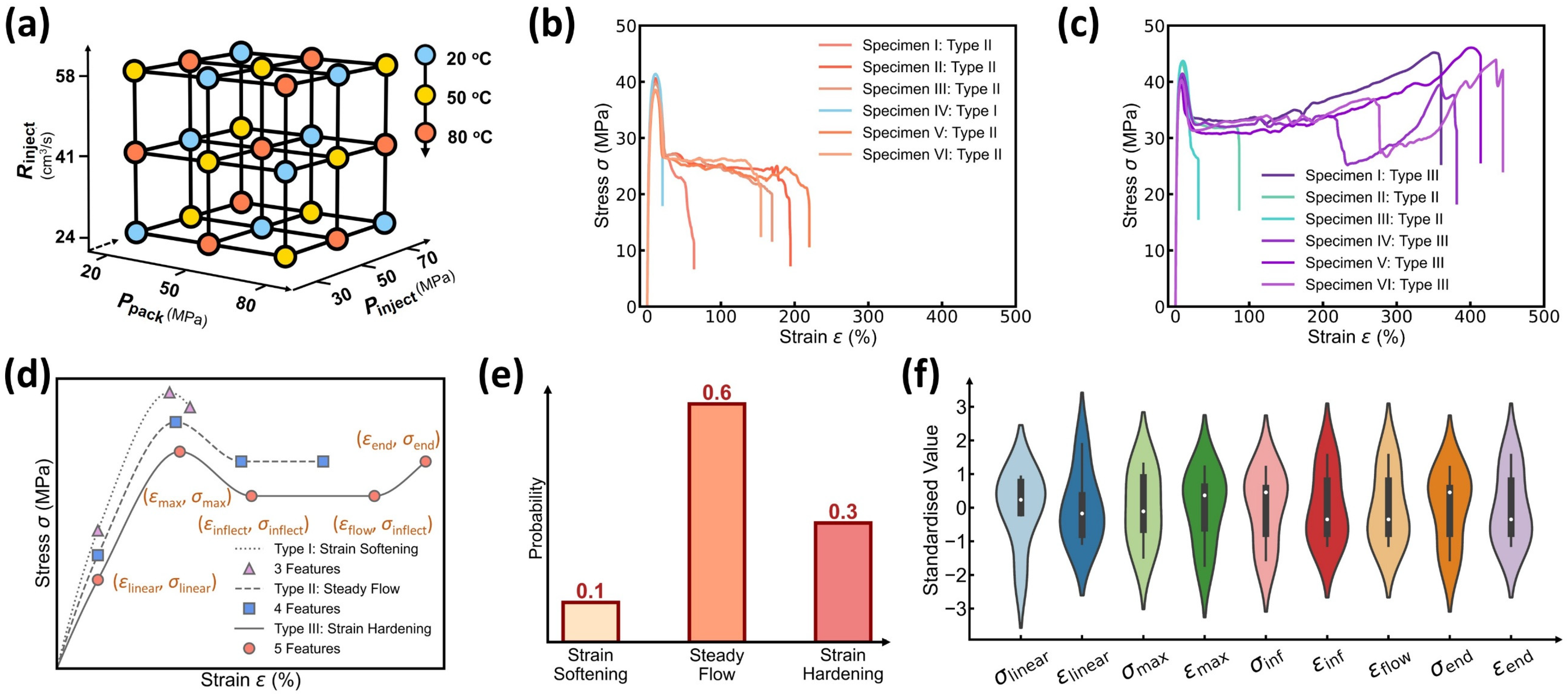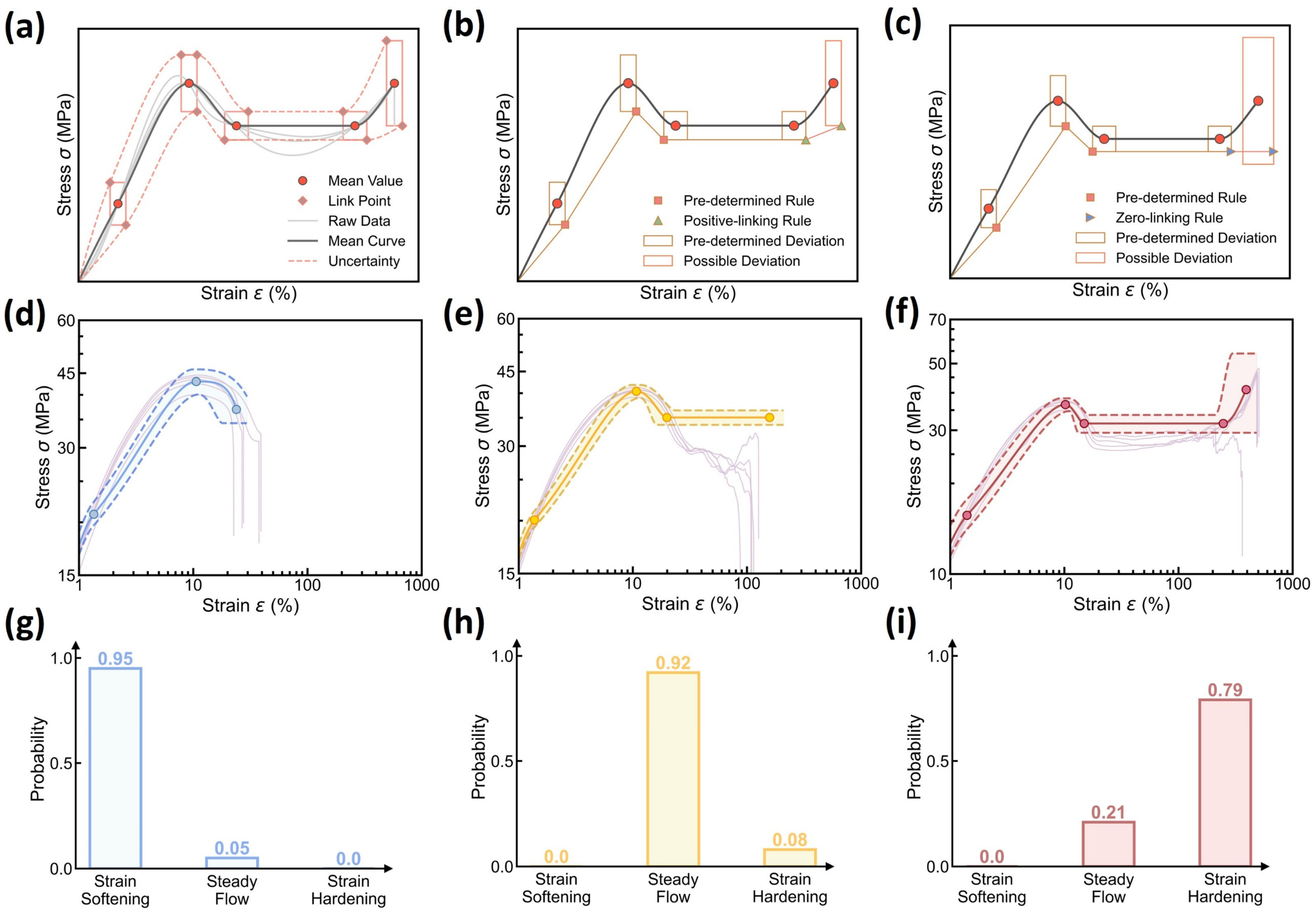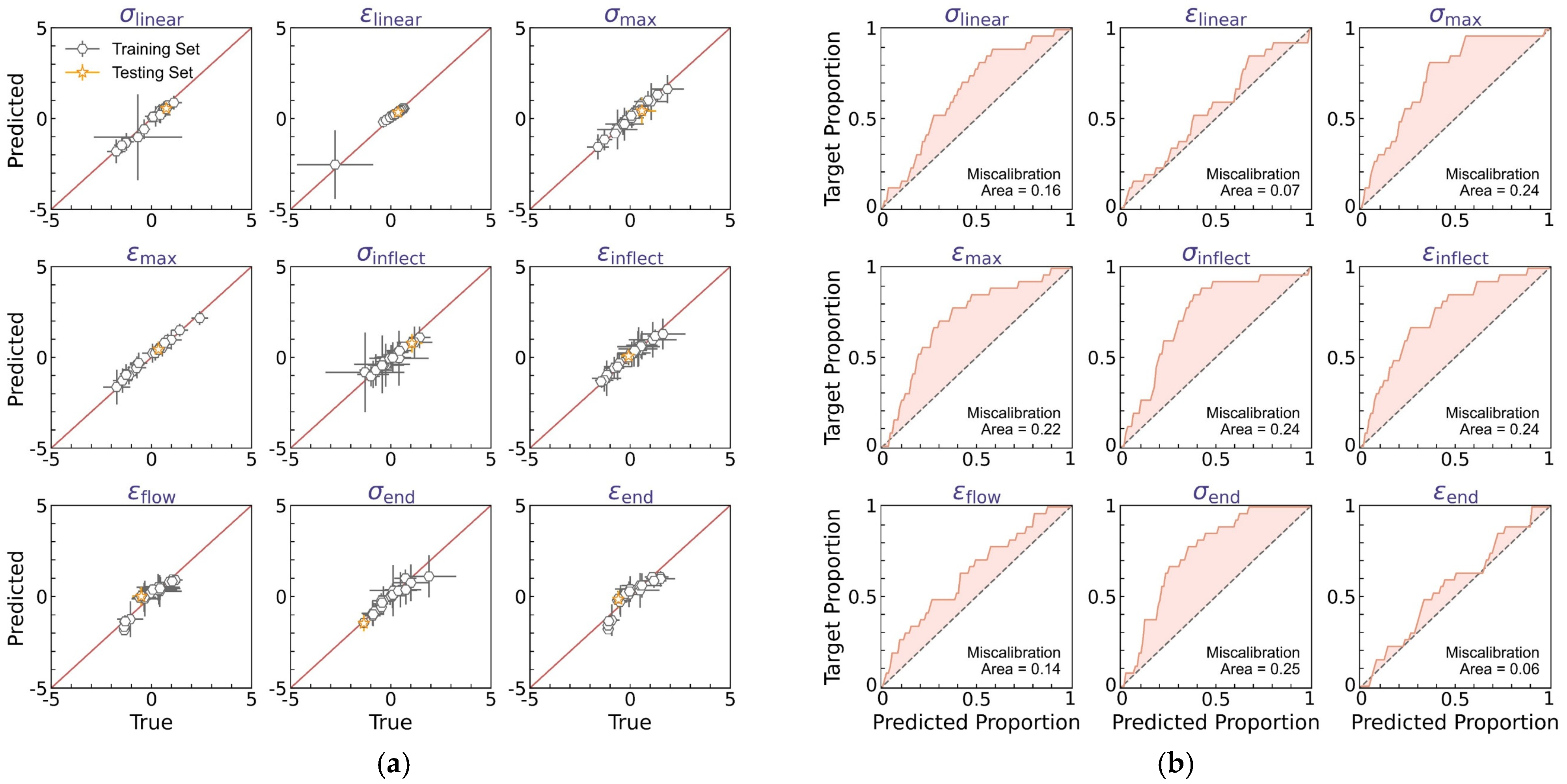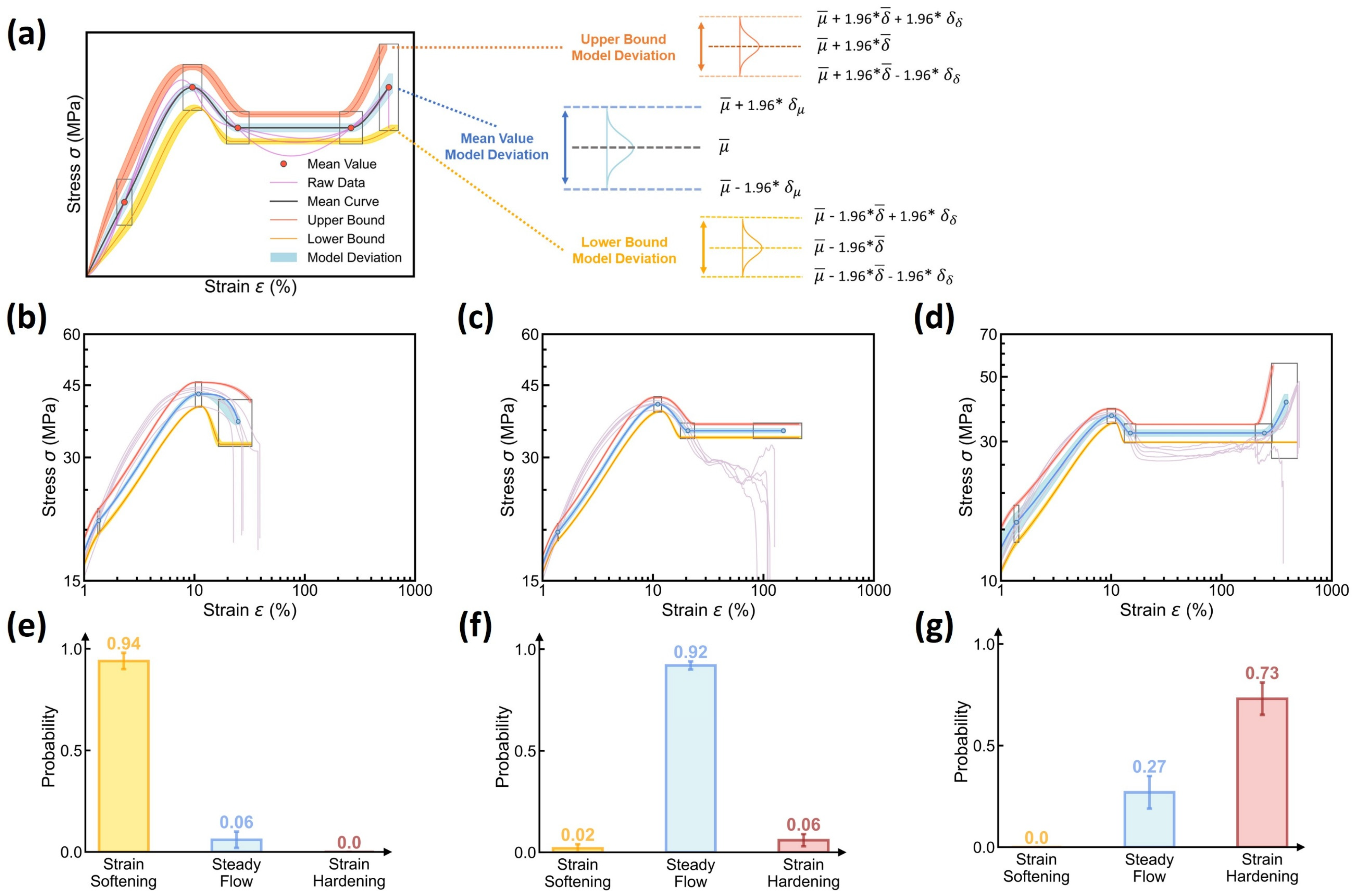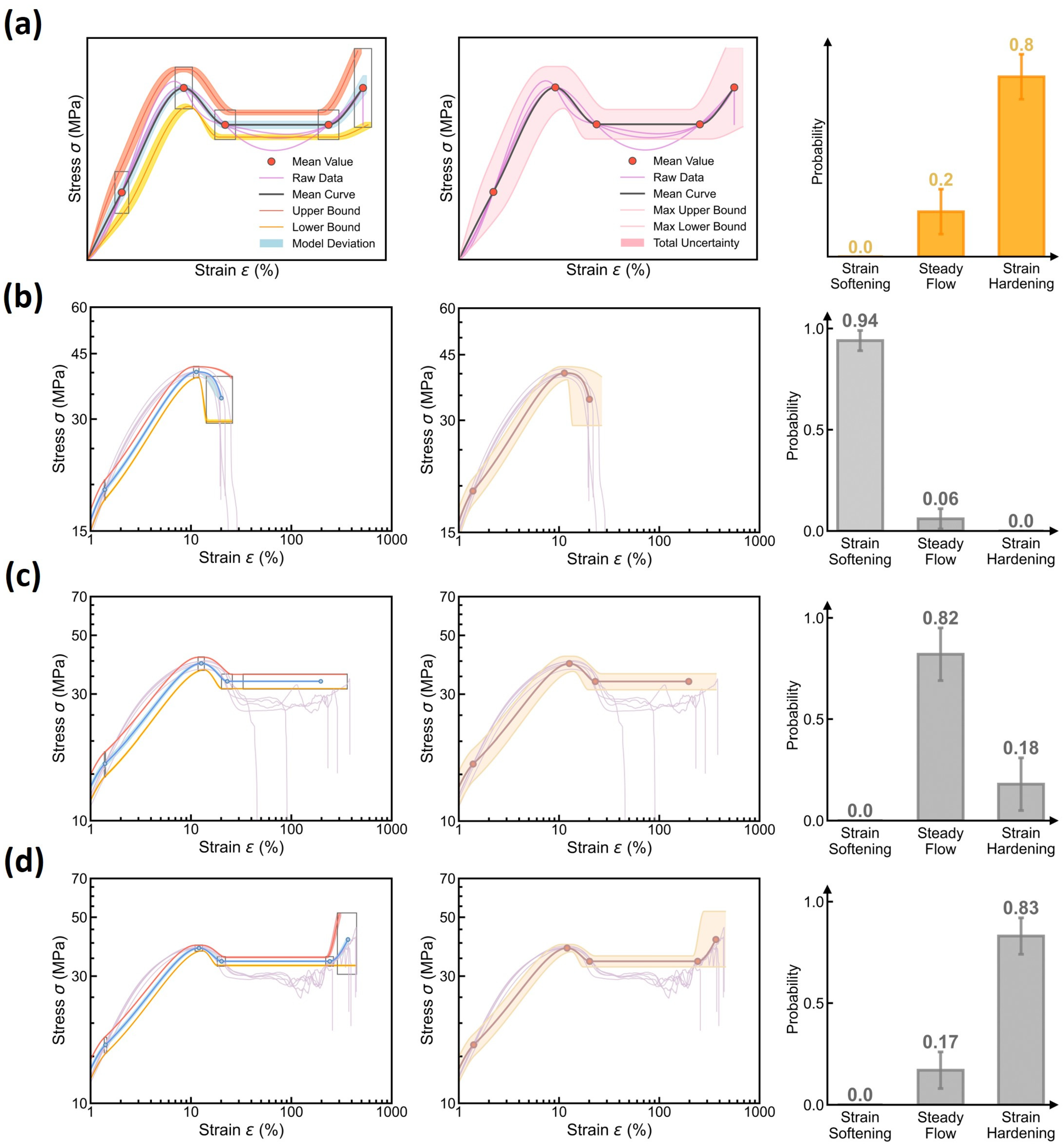3.1. Description of the Stress–Strain Curve Dataset
- (1)
Mini-Dataset Construction by Taguchi Sampling Representation
To build a small-sized but high-quality dataset, we utilize herein the Taguchi orthogonal method, a robust experimental design technique that minimizes the number of experiments needed to create a mini-dataset of 27 molding conditions (see
Figure 2a) [
1,
23]. Each condition with four adjustable processing parameters, namely,
, varies two parameters from surrounding conditions using three levels of alteration in the 4D processing parameter space, with orthogonal arrays systematically ensuring even distribution of experiments across the entire parameter space and providing an informative representation of the stress–strain curve evolution as a function of processing parameters. For each of the 27 molding conditions, 3 to 7 iPP injection-molded specimens are used to characterize the aleatoric uncertainty of stress–strain curves at each condition or to ensure their statistical replicability, resulting in a total of 152 curves in the dataset. This Taguchi sampling strategy is capable of covering the entire 4D design space with an extremely small yet highly informative dataset. As a
posteriori validation, the resultant model predictivity would manifest the Taguchi-guided dataset’s high quality (see
Section 3.3).
- (2)
“One-to-Many” Curve Variation at Each Molding Condition
We now take a close inspection into the stress–strain curve patterns at each molding condition.
Figure 2b,c show two example sets of iPP specimens’ stress–strain curves at two molding conditions, respectively, wherein the curve patterns follow the typical mechanical behaviors of semicrystalline polymers and exhibit complex multiple regimes [
24,
25,
26,
27,
28,
29], including strain softening regime, steady flow regime, and strain hardening regime (see
Figure 2d), governed by iPP’s complex microstructural evolution. Notably, at each molding condition, the stress–strain curves exhibit high aleatoric uncertainty and show an extent of fluctuation—especially for the elongation at break—that is, the “one-to-many” issue, which is ascribed to the intrinsic and inevitable fluctuations of processing parameters and the specimens’ microstructural discrepancy thereof. To address the “one-to-many” issue, the curve variation at each molding condition would be simplified into a dual distribution representation for DNN model construction (see
Section 3.2 and
Section 3.3).
3.2. Simplifying the “One-to-Many” Variational Curve Representation by a Dual Distribution
- (1)
Categorical-Distributed Nature of Curve Type
Since ML model training strictly follows the principle of “one-to-one” unique mapping between inputs and outputs [
13], we address herein the issue of “one-to-many” curve variation at each molding condition by simplifying each set of stress–strain curves at one condition as a dual distribution—that is, a coupled distribution of curve types and features, ready to reconstruct the expected stress–strain curve and its aleatoric uncertainty (see
Section 3.3). Accordingly, the ML model would output a dual distribution that describes the curve variation at each molding condition, rather than simultaneously outputting the many different curves themselves that would be out of the model’s capability.
Regarding the dual distribution, we first investigate the categorical distribution of curve type at each molding condition. Based on the variation in iPP’s mechanical response, the curve type can be categorized into three groups, as illustrated in
Figure 2d, as follows: (i) Type I, which is characterized by strain softening; (ii) Type II, which exhibits steady flow; and (iii) Type III, which displays strain hardening after steady flow. Notably, the stress–strain curves at one molding condition generally have the same curve type or exhibit a dominant curve type with a few exceptions, as shown in
Figure 2b,c. Further,
Figure 2e shows an example of curve type distribution at one molding condition, which covers all three curve types with one curve type dominating, highlighting the categorical distributed nature of curve type at each molding condition. Accordingly, this probabilistic distribution would be forecasted by constructing an ML classifier configured with a categorical distribution output layer (see
Section 3.3).
- (2)
Approxi-Normal-Distributed Nature of Curve Feature Point
Next, we investigate the distribution of curve features associated with five feature points that dictate the evolution trend of stress–strain curves, as illustrated in
Figure 2d, including (i) the linear limit point (
), which marks the end of the linear change of the curve; (ii) the maximum yielding point (
), where the curve meets the first peak and the slope turns from positive to negative; (iii) the strain softening inflection point (
), where the curve curvature starts to change from negative to positive; (iv) the steady flow limit point (
), which has the same stress value but more elongation; and finally, (v) the fracture point (
) when the curve ends. Note that, instead of predicting the entire curve points, predicting solely the five feature points—together with the dominant curve type information—is ready to reconstruct the corresponding stress–strain curve (see
Section 3.3), thus significantly reducing the ML model complexity and the data size requirement.
Figure 2f shows a violin plot of the distribution of curve features at one molding condition, wherein the white point indicates the median, the shape’s width reflects data frequency, and each feature has been standardized for illustration purposes. To a moderate extent, all curve features share more or less similar distribution characteristics, with an approxi-symmetric or slightly skewed peak centered around zero, highlighting the approxi-normal distributed nature of curve features. For simplicity, these curve feature distributions would be forecasted by constructing an ML regressor configured with a normal distribution output layer (see
Section 3.3), that is, approximating each curve feature’s aleatoric uncertainty by a normal distribution.
3.3. Predicting the “One-to-Many” Variational Curve by a Dual-Distribution Neural Network
- (1)
Dual-Distribution Neural Network Architecture
To predict the dual-distribution representation of curve variation at each molding condition, we construct herein a dual-distribution neural network (DNN) model.
Figure 3a shows the DNN model architecture built by a parallel integration of a curve-type classifier and a curve feature regressor, which takes molding condition as input and is responsible for outputting a distribution of curve type and feature, respectively. Note that, regarding the output-distribution format, the curve-type classifier adopts a categorical distribution output layer and outputs a categorical distribution, as represented by three probability values associated with three curve types (see
Figure 3a), while the curve feature predictor adopts a normal distribution output layer and outputs a normal distribution for each curve feature, as represented by its mean value
μ and standard deviation
δ (see
Figure 3b).
Given the dual-distribution output at each molding condition, its expected stress–strain curve is ready to reconstruct, with an aleatoric uncertainty provided, as illustrated in
Figure 3c. Note that, since the curve feature predictor would yield nonnull outputs for all curve features and cannot distinguish the curve type, a dominant curve type must be provided by the curve type classifier for stress–strain curve reconstruction. More technical details about the reconstruction rules are provided in the following section (see
Section 3.3-(3)). Overall, the DNN architecture, combining the curve type classifier and curve feature regressor, forms a knowledge-informed neural network (KINN). This approach leverages the state-of-the-art simplicity of reduced hidden neurons for stress–strain curve prediction [
1], with a total of 83 hidden neurons for the curve type classifier and 100 hidden neurons for the curve feature regressor, significantly reducing the data size requirement while maintaining model accuracy (see
Section 3.3-(2)).
- (2)
Prediction Accuracy of the Dual-Distribution Neural Network
Now, we investigate the DNN model’s training performance and prediction accuracy. Regarding the DNN training process, the classifier and regressor are trained independently, and their loss functions are defined as the negative log-likelihood of true data under the predicted distribution. All training hyperparameters have been fine-tuned to optimize the model’s performance. The stochastic gradient descent (SGD) optimizer is adopted to optimize the neuron weights and biases in 2000 epochs, with an initial learning rate of 0.01 and a batch size of 6 curves per molding condition. We observed that the training loss rapidly decreases and plateaus at 0.4 for the classifier and 5.0 for the regressor. Additionally, the root mean square error (RMSE) and categorical accuracy (CA) reach 0.9 and 1, respectively, by the end of training (as shown in
Figure S1). Note that, before training, all data are subjected to preprocessing to ensure the training performance, with the curve features and molding conditions subjected to standardization, and the curve types represented by one-hot representation. For null curve features in curve type I and II, the fracture point value is assigned to the null value as the regressor output. More details about the data preprocessing and the training process are provided in the
Supplementary Materials.
Figure 4 shows the prediction accuracy of the curve type classifier, wherein 25 molding conditions are selected as the training set and the remaining 2 conditions serve as the test set, and the confusion matrix of both the training and test sets exhibits a 100% classification accuracy. To validate the classifier’s performance,
Figure 4b provides the stress–strain curves at one test molding condition, and the predicted versus true curve type distribution is provided in
Figure 4c. Impressively, the model prediction assigns a 70% probability to curve type III and a 30% probability to curve type II, offering an excellent agreement with the experimental results of 83% type III and 17% type II. Considering the complexity of curve variations at each condition, the close match between predicted versus true distribution demonstrates the classifier’s capability in predicting the dominant curve type at each molding condition.
Figure 5 shows the prediction accuracy of the curve feature regressor, wherein one molding condition is selected as the test set and the remaining 26 conditions are the training set. As the regressor outputs a normal distribution to quantify each curve feature’s aleatoric uncertainty, we adopt herein two types of
y =
x calibration curves to evaluate the prediction accuracy of the normal distribution’s mean
μ (see
Figure 5a) and standard deviation
δ (see
Figure 5b), respectively.
Figure 5a shows the predicted versus true mean values for each curve feature, with the horizontal and vertical error bars representing the standard deviation of true versus predicted data, respectively. It is notable that all training data points are located around the
y =
x line, with the mean squared error (MSE) less than 0.15, which is considered satisfactory herein. More importantly, when extrapolating to the test condition, the regressor exhibits a reasonably good extrapolability to the test set—despite the training data size being extremely small and the test set being an extrapolation condition uncovered by the training condition regime.
Further, we evaluate the prediction accuracy of the normal distribution’s standard deviation
δ, that is, the aleatoric uncertainty quantification at each molding condition.
Figure 5b shows the average calibration plot of observed versus predicted data proportion in the
α-prediction interval for each curve feature, wherein
α ranges from 0% to 100% to indicate the data proportion falling within the
α-prediction interval. Ideally, the predicted normal distribution is expected to satisfy the requirement that the observed proportion should be equal to
α in the
α-prediction interval, that is, forming a
y =
x line in the average calibration plot. Otherwise, the inconsistency between predicted versus true data distribution can be evaluated by the miscalibration area between the calibration curve and the
y =
x line, which identifies the distribution range deviating from the real data distribution, suggesting either insufficient or excessive uncertainty estimation. We find that, for each curve feature, the predicted normal distribution exhibits a satisfactory accuracy in describing the experimental data distribution, with an average miscalibration area of 0.11. And in most cases, these miscalibrations show a calibration curve above the
y =
x reference line (see
Figure 5b), suggesting a slightly excessive uncertainty estimation, which is potentially beneficial for extrema estimation and reliability guidance thereof. Overall, these results demonstrate that the DNN model can accurately predict the dual-distribution representation of curve variation at each molding condition.
- (3)
Reconstructing Variational Curve from its Dual Distribution Representation
Based on the dual distribution prediction, we can reconstruct the expected stress–strain curve and its aleatoric uncertainty at each molding condition.
Figure 6a–c illustrate the stress–strain curve reconstruction rules. First, given the dominant curve type, the expected mean curve is reconstructed by monotonic spline interpolation between the mean values of relevant curve features. Then in the same spirit, the aleatoric uncertainty of this reconstructed curve is provided by connecting the rectangle vertices associated with these curve feature points, wherein each rectangle represents the extrema boundary that encompasses the corresponding curve feature variation. Herein, the rectangle bounds are constructed using the 95% confidence intervals of curve feature distributions, that is, using
as the lower and upper bounds to maximally cover the variation range of curve feature points. Finally, considering the monotonic increase trend at the strain hardening regime, the connection between rectangle vertices generally follows the positive-slope linking rule (see
Figure 6b), while in some scenarios with substantial fluctuation of the fracture point, the positive-slope linking rule may fail, and to rectify the systematic error, a zero-slope linking rule is applied instead, as shown in
Figure 6c. Overall, the set of reconstruction rules offers a simple yet reliable approach to generate the expected stress–strain curve and its aleatoric uncertainty in an efficient manner.
- (4)
Predicting Curve Variation at Different Molding Conditions
Based on the reconstruction rules, we finally evaluate the stress–strain curve prediction of the DNN model at different molding conditions.
Figure 6d–f showcase the prediction of the reconstructed stress–strain curve at different molding conditions and its aleatoric uncertainty, wherein the experimental curve data are added as a reference, and their predicted curve type distributions are provided in
Figure 6g–i. Indeed, the reconstructed mean stress–strain curves offer an excellent agreement with their experimental curve references, and the established 95% confidence interval can apparently encompass all corresponding raw data curves within the predicted bounds. Further, to evaluate the model’s extrapolability to different molding conditions, we iteratively select from the dataset one molding condition as a test set, while the remaining 26 conditions serve as a training set, and it has been proved that the DNN model remains a reasonably good extrapolability to each test condition (see
Supplementary Materials, Table S1). Despite some discrepancies between the predicted and experimental data, it can be concluded that the DNN model is capable of predicting stress–strain curve variation with a modest and reliable 95% confidence interval—that is, enabling aleatoric uncertainty quantification, ready for extrema estimation and reliability guidance after further incorporating the epistemic uncertainty (see
Section 3.4).
3.4. Beyond Curve Variation: Uncertainty Quantification by Bayesian Neural Network
- (1)
Epistemic Uncertainty Induced by Model Deviation
Relying on the distribution output layer, we have demonstrated that the DNN model can generate a probability density distribution to describe the experimental data distribution and quantify its aleatoric uncertainty. However, given the same experimental data, it is very likely that there exists a set of DNN models with different model parameters that can offer comparable model performance, as illustrated in
Figure 7. In principle, these models can accurately describe the stress–strain curve variation at molding conditions within the experimental dataset but exhibit an evident model deviation between each other in the entire condition range (see
Figure 7), which is ascribed to the uncertainty of model parameters—that is, “epistemic uncertainty” [
17]. Here, relying on the Bayesian inference theorem (see
Section 3.4-(2)), the Bayesian neural network (BNN) approach would be applied to quantify the epistemic uncertainty of the DNN model [
21,
30,
31]. We expect that, by incorporating the epistemic uncertainty, the model prediction would account for not only the data deviation but also the model deviation (see
Figure 7), so as to enhance the prediction accuracy and reliability.
- (2)
Bayesian Inference Theorem
In the provided dataset , where represents input samples and represents output samples, the ML model is trained to produce results through the adjustment of model parameters , where denotes the number of model parameters (i.e., neuron weights and biases) is determined by the number of neurons in the DNN model herein. By minimizing the loss function between the model and the target value , traditional ML models typically seek a specific set of parameters to establish a one-to-one mapping relationship between input samples and output samples .
In contrast, Bayesian methods, represented by Equation (1), provide a unique capability to capture both the aleatoric and epistemic uncertainty by stochastic probability models [
21,
22]:
wherein
is the probability density function (PDF), herein modeled as a normal distribution with a mean of
and a variance of
to quantify aleatoric uncertainty, serving as the prior. It is assumed that the data in the dataset
are independent of each other, allowing the likelihood
to be expressed as Equation (2):
and according to Bayes’ theorem [
30,
31], the posterior PDF
can be computed by Equation (3), which is intrinsically connected to the representation of epistemic uncertainty:
wherein a prior PDF
is set as the independent Gaussian for each weight and bias in BNN neurons, collectively describing the possible distribution of
and
. Then, given the new input
, the predicted output distribution
is defined by Equation (4) as follows:
which represents the total uncertainty consisting of both the aleatoric and epistemic uncertainty. Employing variational inference (VI) to approximate the true posterior
via the BNN model [
31], a factorized Gaussian distribution
is utilized, where the BNN model parameters
comprises the mean and standard deviation in each independent Gaussian to describe the distribution of each neuron weight or bias, as expressed by Equation (5):
By substituting
in Equation (4) with
, the total uncertainty
is derived as Equation (6):
As a result, the mean
and the upper-bound variance
are computed by Equations (7) and (8), respectively [
21,
31]:
wherein the expected mean
(referred to as
below) is calculated via sampling neuron weights and biases from their Gaussian distributions in the well-trained BNN model (see
Figure 8). Accordingly, the aleatoric uncertainty
(referred to as
below) and the epistemic uncertainty
and
(referred to as
and
, respectively, below) can be obtained to evaluate the deviation of data and model separately (see
Section 3.4-(3)).
- (3)
Total Uncertainty Quantification by a Dual-Distribution Bayesian Network
According to the above BNN approach, we construct herein a dual-distribution Bayesian network (DBN) to simultaneously address both the aleatoric and epistemic uncertainty. Compared to the DNN model, the DBN model simply replaces all hidden neurons with the BNN neuron type. Unlike setting a single value for weights and biases in traditional neurons, the BNN neurons use some distribution parameters to describe the distribution of weights and biases (i.e., mean and standard deviation in Gaussian distribution herein), and these distribution parameters are optimized via the same training scheme as the DNN model. After training, we randomly sample from the distributions of weights and biases to output multiple dual-distribution results so that the DBN model is equivalent to multiple DNN models under different settings of weights and biases. By statistically analyzing the multiple outputs based on Equation (8), the DBN model enables quantification of both the aleatoric and epistemic uncertainty.
Figure 8 illustrates the quantification of epistemic uncertainty using the DBN model, wherein the weights and biases in BNN neurons are sampled from their independent Gaussian distributions so that the BNN-based curve type classifier and curve feature regressor are equivalent to multiple classifiers and regressors based on artificial neural networks (ANNs) under different settings of weights and biases. By statistical averaging, the BNN-based classifier outputs the mean probability for each curve type (denoted as
), along with a standard deviation (
) that encapsulates the potential deviation in curve type classification, that is, the epistemic uncertainty of the classifier model (see
Figure 8a). Similarly, the BNN-based regressor yields multiple mean
μ and standard deviation
δ for each curve feature distribution and then statistically averages the multiple values to obtain the expected mean
and aleatoric uncertainty
for each curve feature, along with the standard deviation of
μ and
δ (denoted as
and
) computed as the epistemic uncertainty of the regressor model (see
Figure 8b). Overall, by introducing a BNN hidden neuron into the DNN architecture, the DBN model can not only inherit all the DNN model’s attributes for stress–strain curve prediction but also quantify the epistemic uncertainty of the DNN model toward enhanced model reliability.
3.5. Curve Uncertainty Prediction by the Dual-Distribution Bayesian Model
- (1)
Prediction Accuracy of the Dual-Distribution Uncertainty
We now evaluate the DBN model’s prediction accuracy by taking into consideration the epistemic uncertainty of its dual distribution output. Note that the DBN and DNN model shares the same training scheme, and the training details are provided in
Supplementary Materials. Unlike the DNN model that predicts only one dual-distribution output at a molding condition, the DBN model can generate multiple dual-distribution outputs at the same molding condition, for example, 100 outputs herein, via sampling different combinations of weights and biases from their independent distributions in BNN neurons. The final output of the DBN model is the “dual-distribution uncertainty”—that is, the mean and variance of the multiple dual-distribution outputs (see
Figure 8), which represent, respectively, the aleatoric and epistemic uncertainty in predicting a stress–strain curve at the molding condition.
Figure 9 shows the prediction accuracy of the BNN-based curve type classifier in the DBN model, wherein the dominant curve type at each molding condition is determined by averaging over 100 predictions of curve type distribution, and the confusion matrix of both the training and test sets exhibits a 100% classification accuracy. Similar to the classifier performance in the DNN model (see
Figure 4), the BNN-based classifier offers a curve type distribution in excellent agreement with its experimental data reference (see
Figure 9b,c). Moreover, the predicted distribution contains not only the mean probability for each curve type but also the standard deviation that quantifies the classifier’s epistemic uncertainty, thus fundamentally enhancing the model prediction reliability.
Figure 10 shows the prediction accuracy of the BNN-based curve feature regressor in the DBN model, wherein two types of
y =
x calibration curves are provided to evaluate the accuracy of, respectively, the predicted mean
μ (see
Figure 10a) and variance
δ (see
Figure 10b) of the experimental curve feature distribution. Note that the mean and variance are determined by averaging over 100 predictions of curve feature distribution, as computed by Equations (7) and (8), respectively, and herein, the upper-bound variance is utilized to benefit extrema estimation by combining all sources of uncertainty, that is, a variance of
(see Equation (8)).
Figure 10a shows the predicted versus true mean values for each curve feature, with the horizontal and vertical error bars representing the variance of true versus predicted data, respectively, and the average calibration plot of observed versus predicted data proportion in the
α-prediction interval is provided in
Figure 10b.
Similar to the regressor performance in the DNN model (see
Figure 5), the BNN-based regressor offers a satisfactory match between predicted versus true mean values, with the training set MSE less than 0.15, comparable to that of the DNN model (i.e., an MSE of 0.15, see
Figure 5a). And when extrapolating to the test set, the regressor exhibits evidently better extrapolability than the DNN model (see
Figure 10a), suggesting that the statistical average operation of BNN-based outputs is likely to eliminate the bias effect of model deviation and, therefore, enhance the model’s extrapolability. We then evaluate the predicted upper-bound variance based on the miscalibration area in the average calibration plot for each curve feature (see
Figure 10b). As expected, by considering the upper-bound variance, the predicted normal distribution exhibits an expanded width yet remains satisfactory in describing the experimental data distribution, with an average miscalibration area of 0.18, higher than that of the DNN model (i.e., an area of 0.11, see
Figure 5b), and to a more evident extent, these miscalibrations show a calibration curve above the
y =
x reference line (see
Figure 10b), suggesting an excessive yet modest uncertainty estimation, which is considered to be beneficial herein for extrema estimation.
- (2)
Reconstructing Curve Uncertainty from its Dual Distribution Uncertainty
Based on the dual-distribution output of DBN model, we can reconstruct the expected stress–strain curve and both its aleatoric and epistemic uncertainty, following the same reconstruction rules applied to the DNN model (see
Figure 6).
Figure 11 shows the reconstruction of the stress–strain curve and its uncertainty based on the DBN model. Compared to DNN-based reconstruction, DBN-based reconstruction provides a statistically model-averaged estimation of the expected mean
and variance
of curve variation at each molding condition (see Equations (7) and (8)), fundamentally eliminating the biased-model effect on aleatoric uncertainty quantification. More distinctively, the reconstruction approach introduces two new sources of uncertainty, that is, the epistemic uncertainty of
and
—herein denoted as
and
(see Equation (8))—which are reconstructed as three new uncertainty regions associated to the stress–strain curve’s mean value, lower bound, and upper bound, respectively (see
Figure 11a). For simplicity, each epistemic uncertainty region is approximated by a normal distribution at a 95% confidence interval, given the computed mean (
and
) and variance (
and
). Based on these reconstruction rules, the visualization of the stress–strain curve prediction distinctively differentiates between the aleatoric and epistemic uncertainty.
Figure 11b–d showcase the reconstructed stress–strain curve and its aleatoric and epistemic uncertainty at different molding conditions, wherein the experimental curve data are added as a reference, and their predicted curve type distributions are provided in
Figure 11e–g. Unlike the DNN model solely characterizing the aleatoric uncertainty (see
Figure 6), the DBN model provides a reconstructed stress–strain curve with a taxonomy of different sources of curve uncertainty at each molding condition. Notably, by incorporating epistemic uncertainty, these curve reconstructions remain closely similar to DNN-based reconstructions, revealing that the epistemic uncertainty is controlled within a modest extent at a small data size. When extrapolating to different test molding conditions, it is notable that the DBN model can generally offer modest epistemic uncertainty at a magnitude negligible or comparable to the aleatoric uncertainty (see
Supplementary Materials), demonstrating the reliability of DBN model in predicting stress–strain curve at a modest uncertainty using small-size dataset, with both the epistemic and aleatoric uncertainty differentiated and visualized.
- (3)
Curve Uncertainty Quantification at Different Molding Conditions
Based on the visualized uncertainty sources, we finally establish the maximum uncertainty quantification of the stress–strain curve prediction. According to the upper-bound variance estimation in curve uncertainty (see Equation (8)), the maximum uncertainty can be attained by summing up all uncertainty sources, that is, a normal distribution with a mean
and variance
at 95% confidence interval, as illustrated in
Figure 12a.
Figure 12b–d show some examples of the maximum uncertainty quantification at different molding conditions (see the middle panel), with the uncertainty source visualization and the predicted curve type distribution provided in the left and right panels, respectively. Indeed, we find that the maximum uncertainty boundary can properly encompass its experimental stress–strain curves at each molding condition, especially for those key feature points captured by the curve feature regressor. Note that, despite their satisfactory alignment, the predictions and experimental data exhibit some discernible discrepancies, which deserve future investigations and might be rooted in (i) the predefined normal distribution of curve features and (ii) the monotonic spline interpolation in curve reconstruction rules. Importantly, by summing up all uncertainty sources, we find that the maximum uncertainty remains a modest range slightly larger than its raw data distribution, which echoes the constrained epistemic uncertainty of the DBN model, and these findings remain true when extrapolating to different test molding conditions (see
Supplementary Materials). Based on the modest maximum-uncertainty, it concludes that the DBN model is adept at extrema estimation and reliability guidance, that is, “predict stress–strain curve with confidence”.

